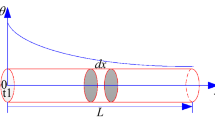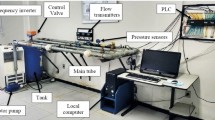Abstract
In the last two decades, soft sensors proved themselves as a valuable alternative to the physical sensor for gathering critical process information. A self-sensing technique for the magnetic bearing is considered as a soft sensor since the object position is estimated from the current signal of the electromagnet. Self-sensing techniques developed so far are the model-driven soft sensors. This paper presents a data-driven self-sensing technique to compensate for the nonlinear characteristic of the electromagnet. First, model-driven self-sensing techniques and their problems are reviewed. Then, data-driven self-sensing technique using recurrent neural network (RNN) is proposed to compensate for the nonlinear characteristics. Both the position control and self-sensing with the RNN are implemented in a single digital signal processor. The effectiveness of the proposed method is experimentally verified by comparison with the current slope method. Both estimation errors during initial levitation and jitter after levitation are reduced by 90% and 36%, respectively. Estimation error with 2 Hz sine wave is improved by 65.9%, while jitter during self-sensing levitation is cut down to 26.8%.











Similar content being viewed by others
Abbreviations
- A g :
-
Cross-section area of E core
- a :
-
Area ratio of E core
- b :
-
RNN bias
- h i :
-
RNN ith hidden layer value
- H :
-
Unit step function
- I :
-
Current
- L :
-
Coil inductance
- N c :
-
Number of PWM period
- R :
-
Coil resistance
- T S :
-
PWM switching period
- u :
-
PWM voltage to drive the coil
- U :
-
RNN input weight
- V dc :
-
DC link voltage
- W :
-
RNN layer weight
- x :
-
Air gap
- x 0 :
-
Nominal air gap
- x n :
-
Discretized air gap
- \({\hat{x}}_{n}\) :
-
Estimated air gap
- X i :
-
RNN ith input value
- β :
-
Voltage coefficient
- γ :
-
PWM duty cycle
- μ 0 :
-
Magnetic permeability of air
- τ :
-
Time constant of coil
References
Kadlec, P., Gabrys, B., & Strandt, S. (2009). Data-driven soft sensors in the process industry. Computers and Chemical Engineering, 33, 795–814
Gu, H., Zhu, H., & Hua, Y. (2018). Soft Sensing Modeling of Magnetic Suspension Rotor Displacements Based on Continuous Hidden Markov Model. IEEE Transactions on Applied Superconductivity, 28(3), 1–5
Liu, T., Zhu, H., Wu, M., & Zhang. W. (2020). Rotor Displacement Self-Sensing Method for Six-Pole Radial Hybrid Magnetic Bearing Using Mixed-Kernel Fuzzy Support Vector Machine. IEEE Transactions on Applied Superconductivity, 30(4), 1–4
Kadlec, P., & Gabrys, B. (2009). Soft sensors: Where are we and what are the current and future challenges? IFAC Proceedings, 42(19), 572–577
Sun, Z., Zhao, J., Shi, Z., & Yu, S. (2014). Soft sensing of magnetic bearing system based on support vector regression and extended Kalman filter. Mechatronics, 24, 186–197
Vischer, D., & Bleuler, H. (1993). Self-sensing active magnetic levitation. IEEE Transactions on Magnetics, 29(2), 1276–1281
Morse, N., Smith, R., Paden, B., & Antaki, J. (1998). Position sensed and self-sensing magnetic bearing configurations and associated robustness limitations. In Proceedings of the 37th IEEE conference on decision and control, Tampa (Vol. 3, pp. 2599–2604).
Thibeault, N., & Smith, R. (2002). Magnetic bearing measurement configurations and associated robustness and performance limitations. Journal of Dynamic Systems, Measurement and Control, 124, 589–598
Park, Y. H., Han, D. C., Park, I. H., Ahn, H. J., & Jang, D. Y. (2008). A self-sensing technology of active magnetic bearings using a phase modulation algorithm based on a high frequency voltage injection method. Journal of Mechanical Science and Technology, 22(9), 1757–1764
Noh, M. D., & Maslen, E. H. (1997). Self-sensing magnetic bearings using parameter estimation. IEEE Transactions on Instrumentation and Measurement, 46(1), 45–50
García, P., Guerrero, J. M., El-Sayed, I., Briz, F., & Reigosa, D. (2010). Carrier signal injection alternatives for sensorless control of active magnetic bearings. In First symposium on sensorless control for electrical drives, Padova (pp. 78–85).
Schammass, A., Herzog, R., Buhler, P., & Bleuler, H. (2005). New results for self-sensing active magnetic bearings using modulation approach. IEEE Transactions on Control Systems Technology, 13(4), 509–516
Niemann, A. C., Van Schoor, G., & Du Rand, C. P. (2013). A self-sensing active magnetic bearing based on a direct current measurement approach. Sensors, 13(9), 12149–12165
Glück, T., Kemmetmüller, W., Tump, C., & Kugi, A. (2011). A novel robust position estimator for self-sensing magnetic levitation systems based on least squares identification. Control Engineering Practice, 19(2), 146–157
Hofer, M., Nenning, T., Hutterer, M., & Schrödl, M. (2014). Current slope measurement strategies for sensorless control of a three phase radial active magnetic bearing. In Proceedings of the 22nd international conference on magnetically levitated systems and linear drives.
Wang, J. (2016). The current slope based position estimation for self-sensing magnetic bearings. Shaker Verlag.
Schweitzer, G., Bleuler, H., & Traxler, A. (1994). Active magnetic bearings: Basics, properties and applications of active magnetic bearings. Vdf Hochschulverlag AG an der ETH Zürich.
Schweitzer, G., & Maslen, E. (2009). Magnetic bearings: Theory design and application to rotating machinery. Springer.
Asama, J., Asami, T., Imakawa, T., Chiba, A., Nakajima, A., & Rahman, M. A. (2011). Effects of permanent-magnet passive magnetic bearing on a two-axis actively regulated low-speed bearingless motor. IEEE Transactions on Energy Conversion, 26(1), 46–54
Bobtsov, A. A., Pyrkin, A. A., Ortega, R. S., & Vedyakov A. A. (2018). A state observer for sensorless control of magnetic levitation systems. Automatica, 97, 263–270
Jiang, Y., Wang, K., Sun M., & Xie. J. (2019). Displacement Self-Sensing Method for AMB-Rotor Systems Using Current Ripple Demodulations Combined With PWM Command Signals. IEEE Sensors, 19(14), 5460–5469
Texas Instruments. (2015). BOOSTXL-DRV8305EVM User’s Guide, https://www.ti.com/lit/pdf/slvuai8.
Acknowledgements
This paper was supported by the Korea Institute of Advancement of Technology (KIAT) Grant funded by the Korea Government (MOTIE) (P0006915, Korea-China Joint R&D Project) and by the Soongsil University Research Fund of 2018.
Author information
Authors and Affiliations
Corresponding author
Additional information
Publisher's Note
Springer Nature remains neutral with regard to jurisdictional claims in published maps and institutional affiliations.
Rights and permissions
About this article
Cite this article
Yoo, S.J., Kim, S., Cho, KH. et al. Data-Driven Self-sensing Technique for Active Magnetic Bearing. Int. J. Precis. Eng. Manuf. 22, 1031–1038 (2021). https://doi.org/10.1007/s12541-021-00525-x
Received:
Revised:
Accepted:
Published:
Issue Date:
DOI: https://doi.org/10.1007/s12541-021-00525-x




